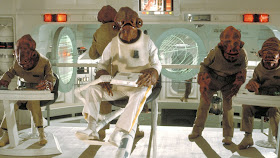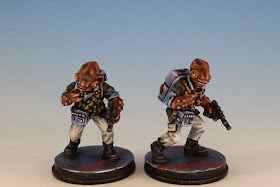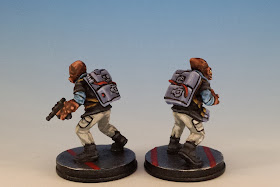Chapter 3 of The Fellowship of the Ring
In Chapter 3, Frodo finally sets out on his quest. But in this Chapter and beyond, Tolkien shows us that this is not just a journey through space. It is also a journey through time... and more specifically, a journey back in time. The fuzzy nature of time is an aspect of The Lord of the Rings that is not often discussed.
This realization about time travel dawned on me when I read the following passage from Chapter 3, in which Gandalf and Frodo discuss escaping the Shire:
"As for where I am going," said Frodo, "it would be difficult to give that away, for I have no clear idea myself yet."The word that arrested my attention here is "post-office". Post-office? Think of what it means to have a post-office (and especially a post-office that offers a mail-forwarding service). It means that there is a high degree of literacy in the Shire (something, in fact, we already know from Chapter 1, where Tolkien mentioned that Bilbo sent out hundreds of invitations and received written replies like Thank you, I shall certainly come.) What does literacy mean? Education. What does education mean? Schools. Schools require prosperity. And prosperity generally requires trade and government.
"Don't be absurd," said Gandalf, "I am not warning you against leaving an address at the post-office! But you are leaving the Shire--and that should not be known, until you are far away."
There are a thousand ways that Tolkien tells us that the Shire is not merely an enclave of subsistence farmers. Rather, it is a civilized, educated and materially complex society, with luxuries that would be unheard of in a medieval setting. Look back again at Chapter 1, at Bilbo's going-away presents to friends and family. These gifts include an umbrella, a set of silver spoons, and a waste-paper basket. Before the Early Modern period, few people owned cutlery, let alone silverware. All Bilbo's presents require sophisticated craftsmanship, but the waste-paper basket is especially remarkable. Until the 19th century, paper, parchment and vellum were rare and expensive commodities in Europe -- so precious that they were reused compulsively. Before the advent of steam-powered paper mills, a waste-paper basket would be like a waste-money basket: a contradiction in terms.
Among the parting gifts, there's also a reference to "a strong red wine from the Southfarthing, and now quite mature, as it had been laid down by Bilbo’s father." This means the bottle in question was at least 75 years old by the time of Bilbo's party, because Bungo Baggins died in 2926. (Incidentally, did you know that Bungo had a brother named Bingo?). In a previous life, I was a wine-critic. So I found Tolkien's throw-away line about this vintage fascinating. Making wine is really hard. For most of the middle ages, wine couldn't keep for more than a few months. Creating a wine that can age for almost a century demands tremendous agricultural know-how, investment and planning. In other words, it's the act of an advanced society.
Perhaps you think I'm taking these details too seriously. Perhaps. But if Middle-Earth has so much linguistic, mythological and historical integrity (and it does), it should also have integrity in the sphere of culture and economics. Tolkien certainly thought it did. In one of his letters, he writes about "the game of inventing a country" and states:
I am more conscious of my sketchiness in the archaeology and realien [German, technical facts] than in the economics: clothes, agricultural implements, metal-working, pottery, architecture and the like. Not to mention music and its apparatus. I am not incapable of or unaware of economic thought; and I think as far as 'mortals' go, Men, Hobbits and Dwarfs, that the situations are so devised the economic likelihood is there and could be worked out... (Letter 154, Sept. 25, 1954)So when Tolkien inserts post-offices and silverware into the Shire, he's doing it with great care.
Put this all together, and what do you have? The Shire begins to resemble a district of England during its mercantile heyday in the 18th and 19th centuries. Of course, you don't have to take my word for it. In another one of his letters, Tolkien observed to his publishers that the Shire "is in fact more or less a Warwickshire village of about the period of the Diamond Jubilee" (Letter 178, Dec. 12, 1958). Queen Victoria's Diamond Jubilee was in 1897.
1897?! That makes the Shire closer to steampunk than to classical fantasy. But if the book starts out in an advanced time period, it certainly doesn't stay there. And that's why I say that Frodo's journey is a trip through time as well as through space. One of his first stops, Bree, seems more like a medieval village than a Victorian countryside. And after that, Frodo enters into the unpopulated wilderness belonging to the Dark Ages.
I'm not trying pin the world of Middle-earth to a specific period (or periods!) of real-world history -- that was clearly never Tolkien's intent; he wanted Middle-earth to stand as its own independent creation (or, as he would call it, a subcreation.) However, I do think it's important to appreciate that the world of The Lord of the Rings is not as homogeneous as we might think (or as homogeneous as its portrayed in movies and role-playing games). Rather, Tolkien had a playful and elusive sense of time and technological advancement. The Shire is Victorian, Rohan is Beowulfian, and Isengard is industrial. The beauty of Tolkien's vision is that these disparate settings cohere into a single mosaic.
There's also an important story-telling function to these shifts through time. By starting his story in a semi-modern setting, Tolkien was making it easier for his readers to identify with the Hobbits (an important technique that I've written about before). Along with Frodo and company, we venture out of our own comfortable home into a strange and perilous world -- a different time and a different place. That journey begins in Chapter 3. For me, there's no better moment to see this shift take place as when (in this chapter), Frodo, Sam and Pippin meet the company of Elves led by Gildor. The Hobbits hear the elves sing a song about the great Valar queen Varda:
O stars that in the Sunless year
With shining hand by her were sown,
In windy fields now bright and clear
We see your silver blossom blown!
What struck me here was the line about the stars being created in "the Sunless year". Anyone who's read The Silmarillion will recognize this as a reference to the ancient period thousands of years before the War of the Ring -- a period predating even the creation of the sun and the moon. This is not just a poetic image: Varda literally placed the stars in the sky to help the fight against the dark lord Morgoth. With this song, Tolkien tells Frodo (and us!) that we too are leaving familiar things behind and stepping into a mythic age.
To read on, here is my commentary on Chapter 4. Or you can find my commentary on Chapter 2 here.
[Image credit: The Brothers Hildebrandt "The One Ring" Acrylic on Board.]
To read on, here is my commentary on Chapter 4. Or you can find my commentary on Chapter 2 here.
[Image credit: The Brothers Hildebrandt "The One Ring" Acrylic on Board.]












